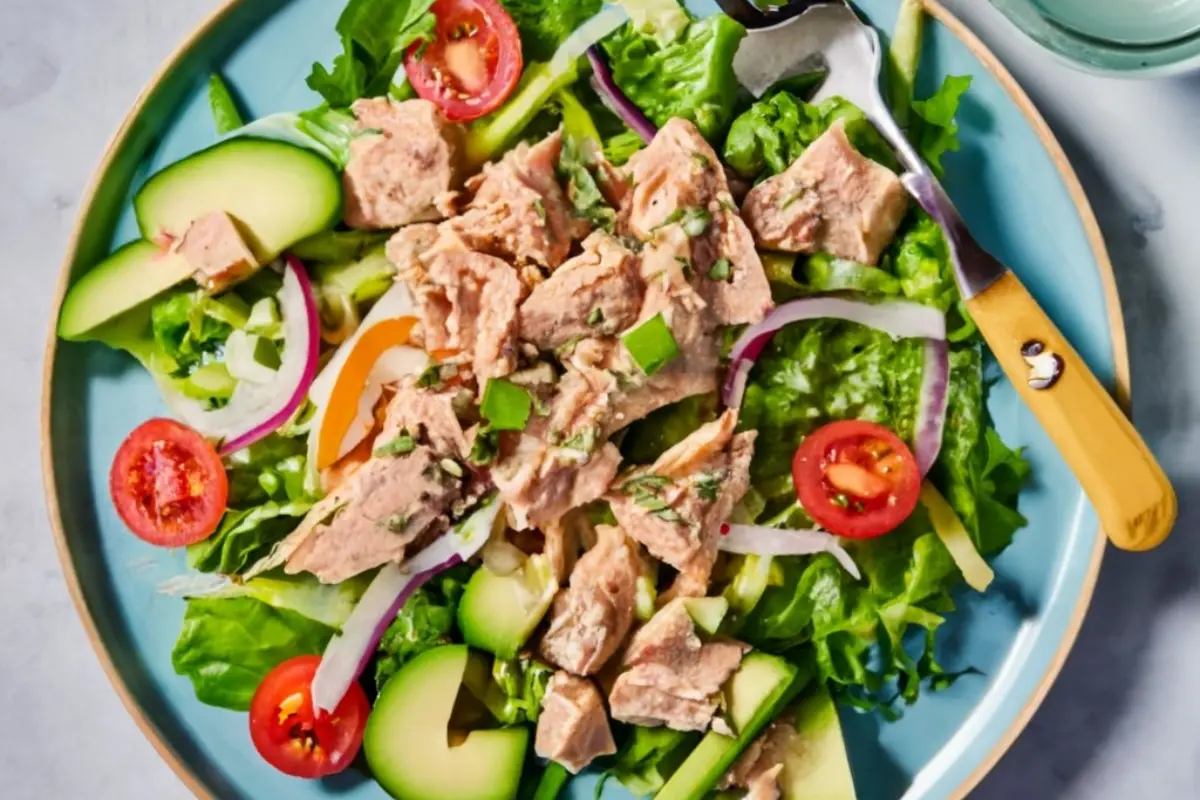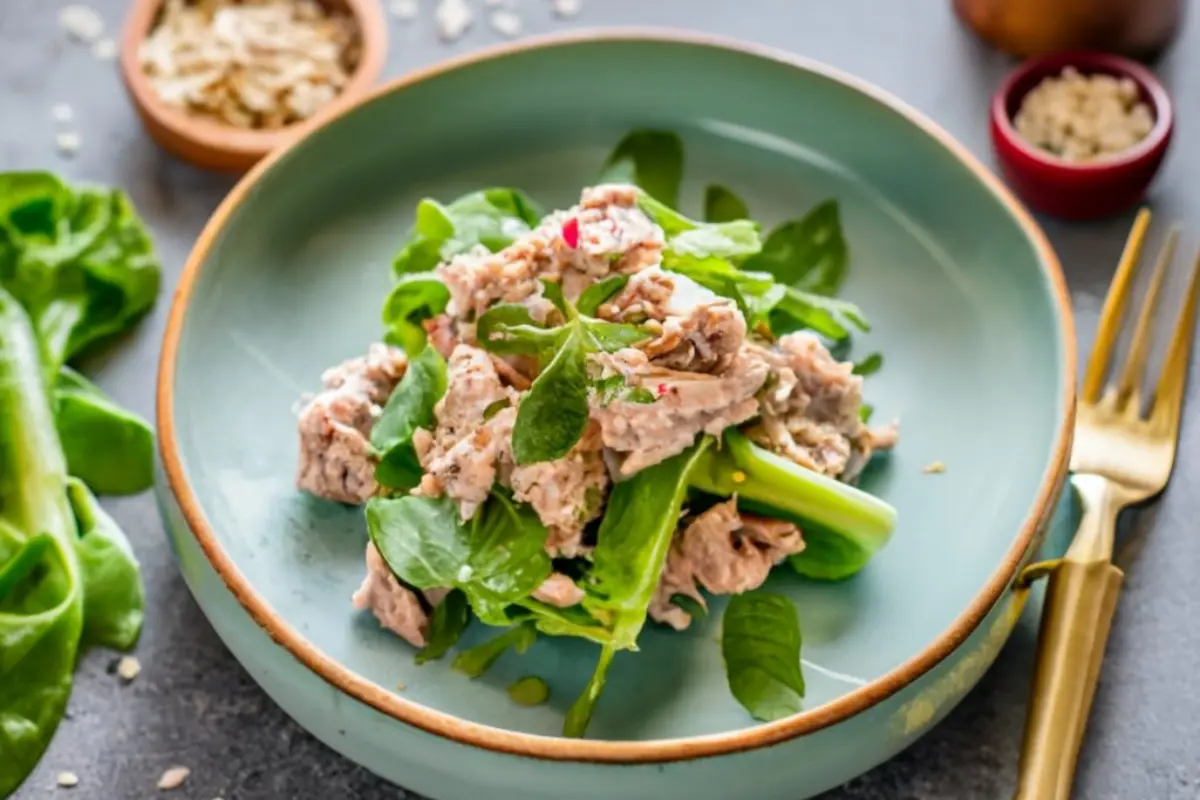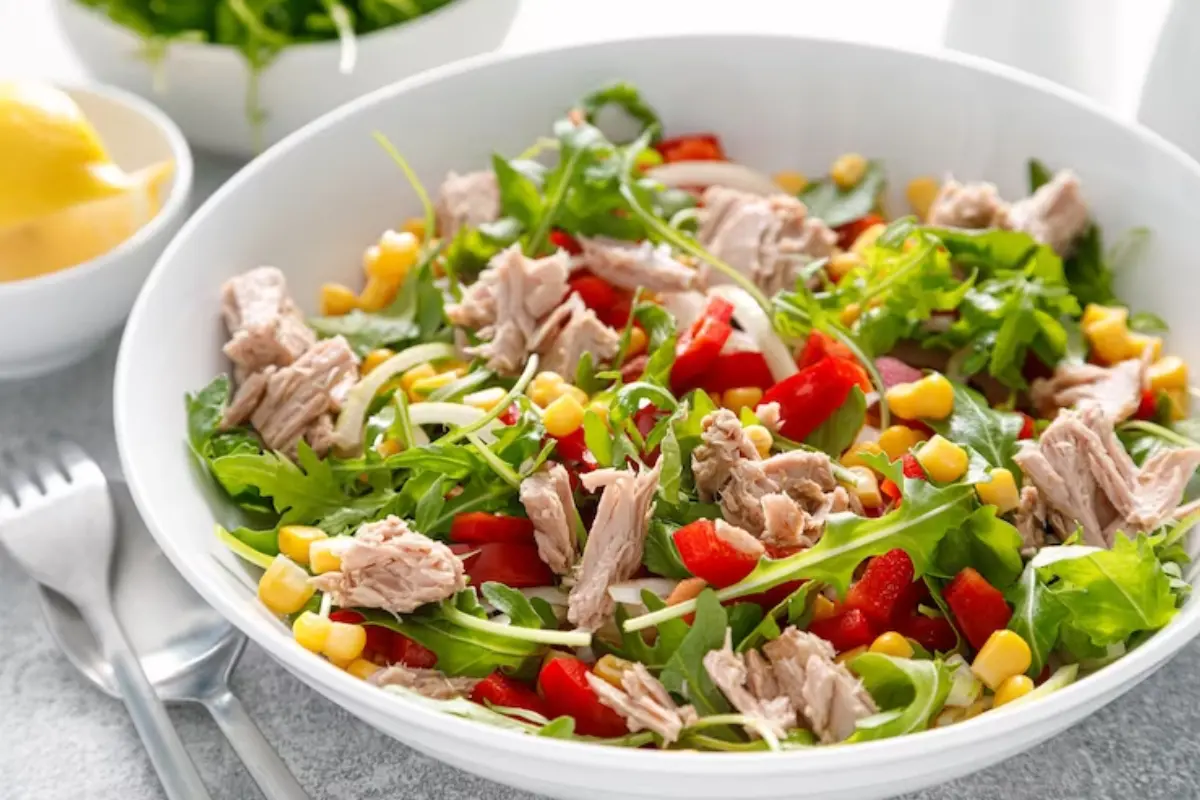Signs of Spoilage in Tuna Salad
Smell, Color, and Mold
Recognizing when tuna salad has gone bad is key to ensuring you consume only fresh, safe food. There are several indicators to watch out for, and your senses are your best tools here.
Smell: Fresh tuna salad typically has a mild, slightly fishy odor. If you detect a rancid or overly strong smell, it’s a clear sign that the salad is no longer safe to eat. Bacterial growth can cause unpleasant odors, so trust your nose – if it smells off, it’s time to toss it.
Color: Pay attention to any changes in color. Fresh tuna salad usually has a light pink or beige hue, depending on the ingredients. If you notice any darkening, greenish tints, or overall discoloration, it’s an indication that the salad is past its prime. These color changes can result from oxidation or bacterial growth.
Mold: This is a definite no-go. If you see any mold, sliminess, or fuzziness on the surface or edges of the container, the tuna salad is spoiled and should be discarded immediately. Mold can develop even in refrigerated conditions, so always inspect your salad before eating.
It’s also important to consider the time factor. If your tuna salad has been stored beyond the recommended 3-5 days in the refrigerator, it’s safer to err on the side of caution and dispose of it, even if it looks and smells fine. Foodborne pathogens can be present without any visible signs, so it’s best not to take chances with your health.
In summary, to ensure you’re eating fresh and safe tuna salad, always check for any off smells, discoloration, or mold. Remember, when in doubt, throw it out!
Next, we’ll delve into the critical aspects of food safety and storage precautions. This section will cover everything from handling precautions to choosing the right storage containers, ensuring that your tuna salad is not just tasty but also prepared and stored in the safest way possible. Stay tuned for these essential tips
Ensuring Safe Consumption
Handling Precautions
When preparing tuna salad, cleanliness and proper handling are paramount. Start by washing your hands thoroughly before handling any ingredients. This simple step can significantly reduce the risk of contaminating your food with harmful bacteria.
Next, consider the surfaces and utensils you’ll be using. It’s advisable to use separate cutting boards and utensils for raw and cooked ingredients to avoid cross-contamination. This is especially important if you’re incorporating ingredients like eggs or if you’re using raw vegetables.
After preparing your tuna salad, it’s crucial to refrigerate it promptly. Leaving it out at room temperature for extended periods can encourage bacterial growth, turning your delightful dish into a potential health hazard.
Choosing the Right Containers
The type of container you use for storing tuna salad can also impact its shelf life. Airtight containers are your best bet, as they keep out air and contaminants, maintaining the freshness of the salad. Glass containers are preferable since they don’t leach chemicals and are less prone to retaining odors. However, if you’re using plastic containers, ensure they are designated as food-safe.
Potential Health Risks
Improper storage and handling of tuna salad can lead to serious health risks, including food poisoning. Symptoms of food poisoning can range from mild discomfort to severe illness, characterized by vomiting, diarrhea, and in some cases, more severe conditions like scombroid food poisoning, particularly when fish is involved.
Another concern is the risk of salmonella, especially when using raw ingredients like eggs in your salad. To mitigate these risks, always practice proper food handling and store your tuna salad in a cool environment, such as a refrigerator.
In summary, safe consumption of tuna salad hinges on good hygiene practices, proper handling, and storage. By following these guidelines, you can enjoy your tuna salad without worry, knowing that it’s not just delicious but also safe to eat.

Role of Ingredients in Shelf Life
Mayonnaise, Vegetables, and Other Additives
The shelf life of tuna salad is significantly influenced by its ingredients. Each component, from mayonnaise to the vegetables, plays a role in determining how long your salad stays fresh and safe to consume.
Mayonnaise: A common ingredient in tuna salad, mayonnaise can be a determining factor in how quickly your salad spoils. Due to its high oil content, mayonnaise-based salads can spoil more rapidly, especially when exposed to warm temperatures. If you’re looking for a longer-lasting alternative, consider using Greek yogurt. While it may alter the texture and flavor slightly, it can extend the shelf life of your salad.
Vegetables: Ingredients like celery, onions, and pickles add crunch and flavor to your tuna salad. However, their water content can also affect the overall shelf life. Vegetables should be thoroughly dried before adding them to the salad to prevent excess moisture, which can hasten spoilage.
Lemon Juice and Pickle Relish: Lemon juice, often used for a tangy flavor, can act as a natural preservative, potentially extending the freshness of your salad. Similarly, pickle relish, with its acidic nature, can also contribute to preservation, adding both flavor and longevity.
Avocado: While avocado can make your tuna salad creamier and more flavorful, it oxidizes quickly. This can lead to browning and faster spoilage. If you’re using avocado, consider consuming the salad sooner rather than later.
Seasonings: Ingredients like dill, garlic, spices, and mustard can enhance the flavor of your tuna salad without significantly impacting its shelf life. Salt and black pepper are essential seasonings that don’t notably affect freshness.
Alternative Binders: Using hummus as a binding agent instead of mayonnaise or Greek yogurt can be a healthier option. However, it may change the overall texture and taste of your salad.
In summary, the ingredients you choose for your tuna salad not only affect its flavor but also its shelf life. By understanding the impact of each component, you can make informed decisions to ensure your salad remains fresh and enjoyable for as long as possible.
Exploring Tuna Salad Varieties
Tuna salad is a versatile dish, adaptable to various tastes and dietary needs. From the classic recipe to innovative, health-conscious versions, there’s a tuna salad for every palate.
Classic Tuna Salad Recipe
The classic tuna salad typically includes canned tuna, mayonnaise, mustard, and a mix of vegetables like celery and onion. It’s a beloved version for its simplicity and familiar taste. This traditional recipe is perfect for sandwiches, wraps, or as a standalone dish. The key to a great classic tuna salad is balancing the flavors and textures of the ingredients.
Healthy Tuna Salad
For those seeking a healthier alternative, there are several ways to modify the classic recipe. Using light or reduced-fat mayonnaise, or substituting mayonnaise with Greek yogurt, can significantly reduce the fat content. Incorporating additional vegetables, such as bell peppers or cucumbers, not only adds crunch but also increases the nutritional value. Fresh herbs like parsley or cilantro and a splash of lemon juice can enhance the flavor without adding extra calories.
Healthy tuna salad can be a refreshing addition to wraps, salads, or even as a filling for stuffed tomatoes or bell peppers, offering a nutritious and satisfying meal.
Vegan Tuna Salad
For vegan preferences, tuna salad can be creatively reinvented by substituting tuna with plant-based protein sources like chickpeas. These alternatives can be mashed and mixed with vegan-friendly dressings and ingredients to mimic the texture and flavor of traditional tuna salad. Vegan tuna salad is not only an ethical and environmentally friendly choice but also offers a new dimension of flavors for those looking to diversify their diet.
Dressing Variations
The dressing can make or break a tuna salad. Apart from the traditional mayonnaise, there are numerous dressing options to explore. Olive oil and vinegar or lemon juice offer a lighter alternative. Pesto or chimichurri sauce can introduce a herby, vibrant twist. For a creamier texture, tahini-based or avocado-based dressings are excellent choices.
Bread and Toppings
Switching up the bread can also transform your tuna salad experience. Opting for whole grain or multi-seed bread can add nutritional value and a different texture. Adding lettuce, tomatoes, or sprouts can elevate a simple tuna sandwich into a more complex and satisfying meal.
In summary, tuna salad is a dish limited only by your imagination. Whether you prefer the classic version, a healthier alternative, or a vegan-friendly option, there’s a way to tailor it to your taste and dietary needs. With a variety of dressings, bread, and toppings to choose from, you can enjoy this versatile dish in countless delicious ways.

Nutritional Profile of Tuna Salad
Tuna salad is often lauded for its nutritional benefits, particularly its high content of omega-3 fatty acids. These essential nutrients are known for their heart health benefits, brain function support, and anti-inflammatory properties. However, it’s important to consider the overall nutritional value of tuna salad, as it can vary significantly based on the ingredients used.
Omega-3 Fatty Acids and Mercury Content
One of the main attractions of tuna salad is its omega-3 fatty acid content. These fatty acids are crucial for maintaining good health, but it’s essential to balance this benefit with the potential risks associated with mercury in tuna. Tuna, like many fish species, can accumulate mercury in their tissues. Consuming large amounts of tuna, especially varieties with higher mercury levels, can pose health risks. This is particularly concerning for pregnant women, nursing mothers, and young children. Opting for light tuna, which generally contains lower mercury levels, is a safer choice for making tuna salad.
Nutritional Breakdown
The nutritional value of tuna salad can vary, especially with different ingredients like mayonnaise and relish, which can add fat, sodium, and calories. Here’s a general breakdown for a typical homemade tuna salad (per 100g serving):
- Calories: 250
- Fat: 18g
- Sodium: 430mg
- Sugars: 2g
- Omega-3 Fatty Acids: 1.2g
To create a healthier version of tuna salad, consider using light mayonnaise or yogurt to reduce fat and calorie content. Adding more vegetables, such as celery or carrots, can increase fiber and other essential nutrients, enhancing the salad’s overall nutritional profile.
Healthier Alternatives
For those looking to enjoy tuna salad with fewer health concerns, there are several alternatives. Using ingredients with lower mercury content or opting for plant-based versions can reduce the risk associated with mercury. Additionally, incorporating a variety of vegetables and using healthier dressings can make tuna salad a more balanced and nutritious meal.
In summary, while tuna salad offers many health benefits, it’s important to be mindful of the ingredients and potential health risks. By making informed choices about the type of tuna and additional ingredients, you can enjoy this delicious dish in a way that aligns with your dietary preferences and health goals.
Enhancing Your Tuna Salad Experience
Tuna salad, with its versatile nature, offers a canvas for culinary creativity. Whether you’re a fan of the classic recipe or enjoy experimenting with new flavors, there are numerous ways to enhance your tuna salad experience. Here are some tips and tricks to add variety and excitement to this beloved dish.
Incorporate Other Salads
Mixing tuna salad with other types of salads can create a delightful fusion of flavors and textures. Consider combining it with a potato salad, chicken salad, or even an egg salad. This not only diversifies the taste but also adds nutritional value, making your meal more satisfying and wholesome.
Add Some Crunch
Introducing elements of crunch can transform the texture of your tuna salad. Chopped celery, nuts, or even a sprinkle of crispy potato chips can add an enjoyable contrast to the creamy consistency of the salad. Experiment with different crunchy ingredients to discover your favorite combination.
Think Outside the Bread
While tuna salad is traditionally served on bread, there are many other ways to enjoy it. Crackers, lettuce wraps, or cucumber slices can serve as a base for a lighter, healthier option. These alternatives not only offer a change in texture but also reduce the calorie count, making your meal more diet-friendly.
Perfect for Picnics
Tuna salad is an excellent choice for picnics due to its ease of preparation and transport. When planning an outdoor meal, remember to keep the salad cool and consume it within the safe time frame to avoid spoilage. Opt for high-quality, trustworthy canned tuna for the best taste and a memorable picnic experience.
Creative Additions
The beauty of homemade tuna salad lies in the ability to customize it to your liking. You can add various ingredients to suit your taste preferences. Boiled eggs, olives, apples, raisins, crushed nuts, or seeds are just a few examples of what you can mix in. Each addition brings its unique flavor and texture, allowing you to create a truly personalized dish.
Vegan Options
For those following a vegan diet, tuna salad can still be on the menu. Replace the tuna with plant-based proteins like chickpeas or tofu, and use vegan mayonnaise or dressings. This way, you can enjoy a vegan version of tuna salad that’s equally delicious and satisfying.
In summary, there’s no limit to how you can enjoy tuna salad. Whether you stick to the classic recipe or venture into new culinary territories, these tips can help you make the most out of this versatile and delicious dish. With a bit of creativity and experimentation, you can turn a simple tuna salad into a gourmet delight.
In the realm of culinary delights, the freshness and quality of ingredients play a pivotal role, much like in our beloved tuna salad. For instance, take the exquisite Lemon Blueberry Cheesecake – A Symphony of Flavors, where the freshness of lemons and blueberries defines its delectable taste. This principle of using fresh, high-quality ingredients is akin to selecting the best components for your tuna salad, ensuring not only safety but also an explosion of flavors.
Moreover, the art of cooking and storing dishes like tuna salad is akin to mastering recipes such as the Vesuvio Potatoes – A Culinary Journey. Both require a keen understanding of how to preserve the integrity and flavor of the ingredients. Whether it’s the perfect blend of spices in Vesuvio potatoes or the delicate balance of mayonnaise and lemon in tuna salad, the technique is paramount.




